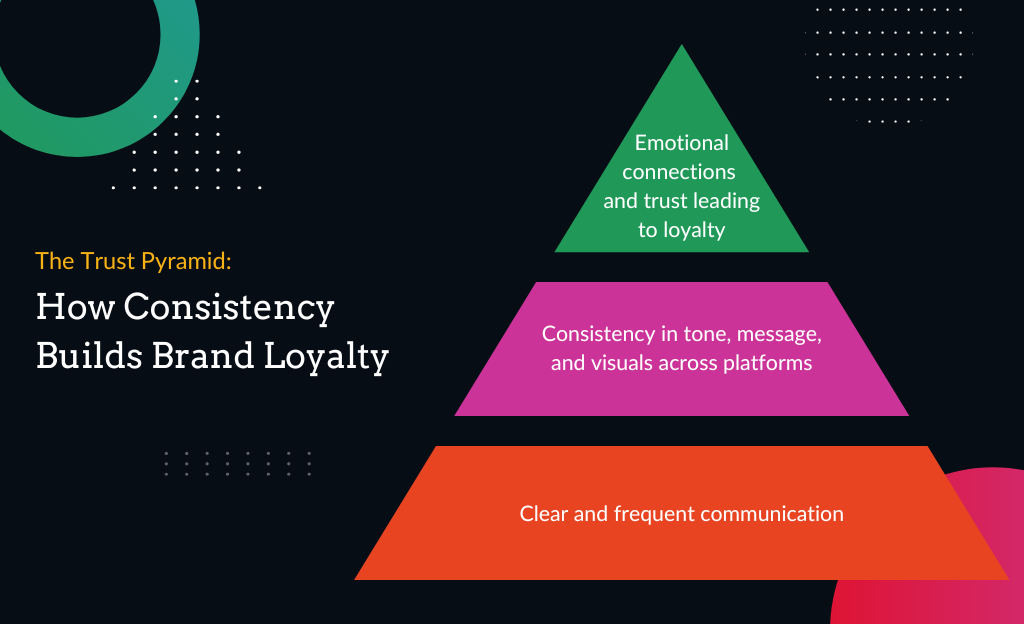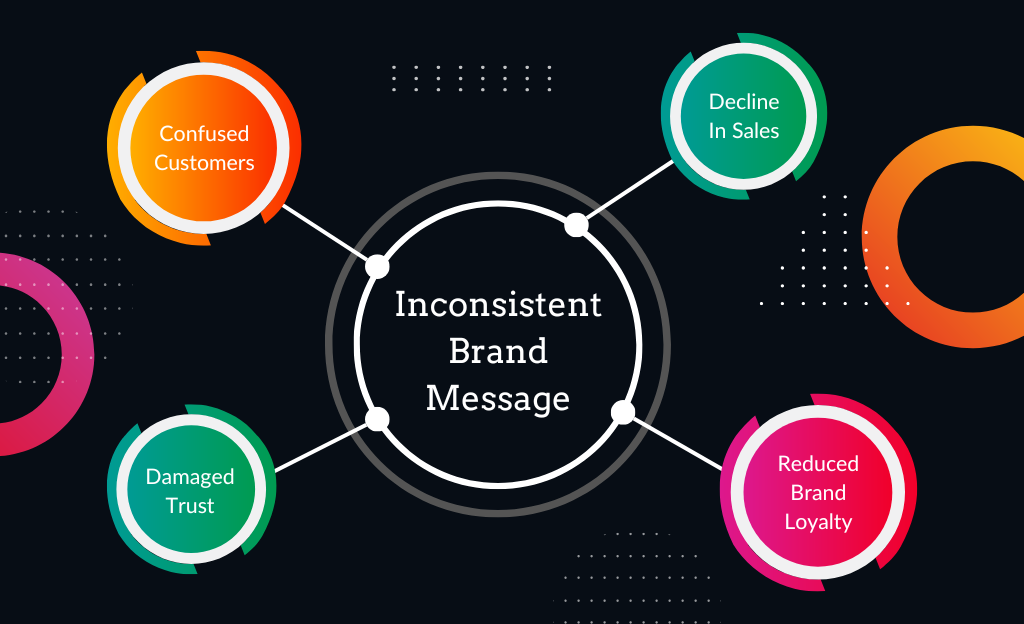The Importance of Consistent Communication for Brand Loyalty

Every interaction you have with your customers shapes how they perceive your brand. From your website copy to your social media responses and customer service emails, every piece of communication should reflect your brand’s tone and values.
Consistent communication is key to fostering trust, building loyalty, and creating a strong connection with your audience. In this post, we’ll discuss why aligning all customer-facing communication with your brand’s tone and values is crucial, how to ensure consistency across channels, and provide examples of communication misalignment and how to avoid them. Let’s explore how consistent communication can strengthen your brand.
Why Consistent Communication Fosters Trust and Brand Loyalty

Every time a customer interacts with your brand-whether they’re reading an email, chatting with a support representative, or engaging with a social media post-they are forming opinions about who you are and what you stand for. Consistent communication helps build trust and loyalty by reinforcing a cohesive brand experience.
Here’s why it matters:
- Builds Trust and Reliability: When your communication is consistent, customers know what to expect from your brand. Whether they’re browsing your website or receiving customer support, they feel reassured that your business is reliable and professional. Inconsistent communication, on the other hand, can lead to confusion and a lack of trust.
- Strengthens Brand Identity: Your brand’s tone and values should come through in every piece of communication, creating a unified identity. Whether your brand is playful, formal, or empathetic, a consistent voice strengthens your identity and makes your brand more memorable.
- Encourages Customer Loyalty: When customers feel a connection with your brand, they’re more likely to stay loyal. Consistent communication fosters a stronger emotional connection because it shows that your brand is dependable and aligned with its values. Over time, this reliability builds customer loyalty and encourages repeat business.
- Enhances Customer Experience: Consistent communication makes the customer journey smoother and more enjoyable. From marketing emails to after-sales service, a consistent tone ensures that every interaction feels familiar and aligned with the customer’s expectations, improving their overall experience with your brand.
How to Ensure Your Communication is Aligned with Your Brand Across Channels

Maintaining consistent communication across various channels can be a challenge, especially when different teams or individuals handle different aspects of customer interactions. However, by taking the right steps, you can ensure that your messaging stays aligned with your brand.
1. Create a Comprehensive Brand Tone Guide
A brand tone guide is essential for ensuring that everyone in your business communicates with the same voice and style. This guide should outline:
- Core Values: Define the principles that guide your business, such as transparency, innovation, or customer-centricity. These values should be reflected in every customer interaction.
- Tone of Voice: Specify the tone that best represents your brand-whether it’s friendly, authoritative, or casual-and provide examples of how to implement it in different scenarios.
- Communication Guidelines: Include clear rules on how to handle specific types of communication, from customer service queries to marketing emails. This helps ensure that your tone remains consistent whether you’re resolving a complaint or announcing a new product.
2. Train Your Team
Even the best brand guide is useless if your team isn’t aware of it or doesn’t know how to implement it. Hold training sessions for everyone who communicates on behalf of your brand, including customer support, sales, and marketing teams. Make sure they understand your brand’s tone, values, and how to apply them in everyday communication.
3. Use Templates for Key Communications
Create templates for common customer interactions, such as:
- Welcome Emails: Ensure the tone reflects your brand and sets the right expectations for future communications.
- Customer Service Responses: Prewritten responses to FAQs or common issues can help maintain a consistent tone, even in high-stress situations.
- Social Media Engagement: Provide guidelines for responding to comments or inquiries on social media, ensuring that the responses reflect your brand’s voice and values.
These templates make it easier for your team to deliver consistent communication while still allowing for personalization.
4. Audit Your Communications Regularly
It’s essential to regularly review how your brand is communicating across platforms. Conduct a communication audit to evaluate emails, social media posts, customer service interactions, and website copy to ensure they all align with your brand’s tone and messaging. If you spot inconsistencies, update the content or provide additional training where necessary.
Examples of Communication Misalignment and How to Avoid Them

Inconsistent communication can confuse your audience, weaken your brand identity, and even erode trust. Let’s look at some common examples of communication misalignment and how to avoid them:
1. Inconsistent Tone Across Channels
Imagine a brand that uses a playful, casual tone on social media but switches to a formal and rigid tone in customer service emails. This inconsistency can be jarring for customers, making them question the authenticity of the brand.
How to Avoid It: Ensure that your tone guide clearly defines the tone for each platform, adjusting slightly for context (e.g., more concise on Twitter vs. more detailed in email) without losing the core personality of your brand.
2. Unclear Messaging During Customer Service Interactions
A brand that communicates one set of values in marketing (e.g., “We prioritise customer happiness”) but delivers poor customer service through dismissive or cold responses creates a disconnect between the promise and the experience.
How to Avoid It: Train your customer service team to embody the values you promote in your marketing. If customer-centricity is a core value, your service reps should reflect this in every interaction-whether it’s solving a problem or answering a question.
3. Varying Levels of Formality
A website might use professional and polished copy, while social media posts might feel too informal, like a completely different brand is behind them.
How to Avoid It: Tailor your communication style to the platform, but maintain the same underlying tone and values. For example, while social media might be more relaxed, it should still reflect the professionalism and expertise seen on your website.

Conclusion: Practical Tips for Aligning Customer Communication with Your Brand
Consistent communication is key to building trust, improving customer experience, and fostering brand loyalty. By aligning all of your customer-facing interactions with your brand’s tone and values, you create a cohesive brand experience that resonates with your audience.
Here’s how to ensure your communication stays consistent:
- Develop a Clear Tone Guide: Create a comprehensive tone guide that outlines your brand’s voice, core values, and communication rules. Make this guide accessible to your entire team.
- Train Your Team: Ensure that everyone who communicates on behalf of your brand is trained in using the tone guide effectively. This includes marketing, sales, and customer service teams.
- Use Templates for Consistency: Create prewritten templates for key customer communications to ensure consistent tone and messaging across all platforms.
- Audit Regularly: Conduct regular audits of your customer communications to identify any inconsistencies and make improvements where necessary.
By following these steps, you’ll not only maintain consistent communication but also strengthen your brand identity and build long-term loyalty with your customers.
Need help aligning your brand’s communication? Contact Sanders Design today, and we’ll work with you to create a cohesive communication strategy that strengthens your brand and builds customer loyalty.


Author: Martin Sanders
I empower businesses to connect with their customers and boost sales. Ready to take your revenue to new heights? Get in touch with me today, and let’s make it happen!


